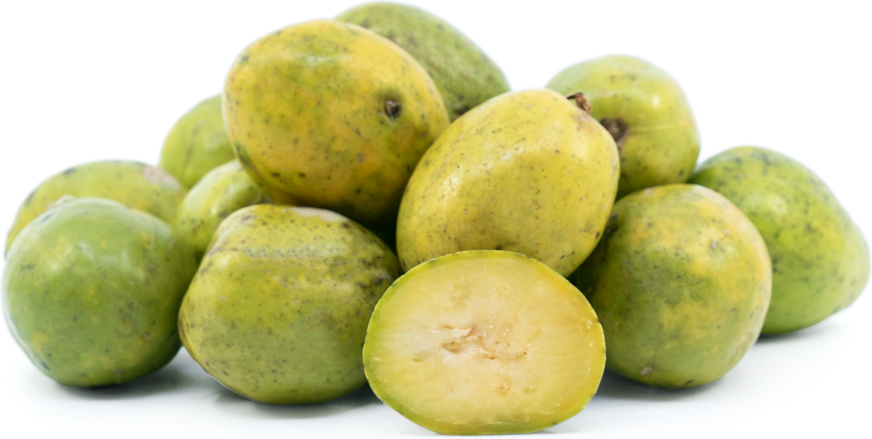


June Plums
Estimated Inventory, lb : 0
Description/Taste
June plums are small to medium in size, averaging 9 to 10 centimeters in length, and grow in dangling clusters of up to twelve fruits. The oval to ellipsoidal fruits have tough, thick skin that may bear some russeting and is bitter and tannic. The fruits mature from green to yellow and can be seen at multiple maturity stages on a single tree, appearing solid green, solid yellow, to variegated hues of green and yellow. Underneath the surface, the flesh is firm, depending on the degree of ripeness, and ranges in color from pale yellow to white. In the center of the flesh, there is also a fibrous pit that contains a few flat seeds. As the fruit matures, the pit's coarse, woody nature extends into the flesh, creating a tough consistency. June plums are crisp, firm, and dense when young with a sweet, pineapple-like taste. As the fruit ripens, it develops a softer, aqueous consistency with a mildly acidic, musky, sweet and sour flavor reminiscent of a combination of soursop, pineapple, mango, and star fruit.
Seasons/Availability
June plums are available year-round, fruiting at different times in tropical climates worldwide.
Current Facts
June plums, botanically classified as Spondias dulcis, are sweet and sour fruits belonging to the Anacardiaceae family. The oval fruits develop in large clusters on fast-growing trees in tropical forests and are known by many regional names, including Ambarella, Jew Plum, Kedondong, Buah Long Long, Golden Apple, and Yellow Egg. June plums are native to Southeast Asia and Polynesia, and over time, the trees have become naturalized in tropical regions worldwide. The fruits can be consumed at any stage of maturity and are favored for their firm flesh and tangy, sweet-tart flavor. June plums are not commercially cultivated and are grown on a small scale for sale in local fresh markets. The trees are also a popular home garden variety. The fruits will fall to the ground when still green and unripe, and families collect the fruits for immediate use. The green, unripe fruits are the preferred stage for consumption as the ripe fruits develop fibrous strands throughout the flesh.
Nutritional Value
June plums are a good source of vitamins A and C, antioxidants that strengthen the immune system, protect the body against free radicals, and to repair tissues within the body. The fruits also contain vitamin K to assist in faster wound healing, calcium to protect bones and teeth, and fiber to regulate the digestive tract. In Asia, June plums are used in natural medicines, shredded into water, and consumed as a drink to help alleviate coughs and fevers.
Applications
June plums can be consumed at any stage of maturity and are utilized in both raw and cooked applications. When eaten fresh, the green, unripe fruits are commonly peeled, sliced, and sprinkled with salt, sugar, shrimp paste, or chile powder for added flavoring. Green June plums can also be sliced and tossed into salads, juiced and mixed in with other fruits, or mashed with spices into a paste. In addition to raw preparations, June plums are often cooked into jams, preserves, and jellies or are simmered into sauces and chutney. They are also boiled in soups, curries, and stews, pickled for extended use, or stewed in sugar water and mashed to create an applesauce-like consistency. June plums pair well with aromatics such as onions, ginger, and garlic, spices such as cinnamon, cardamom, curry leaves, and mustard leaves, seafood, meats such as beef, pork, lamb, and poultry, brown sugar, vanilla, and fruits such as citrus, mangoes, and papaya. The fruits will keep up to one week when stored at room temperature and 2 to 4 weeks when stored in the refrigerator.
Ethnic/Cultural Info
On the island of Trinidad in the Southern Caribbean, June plums are frequently incorporated into a dish known as chow. This famous dish mixes sweet, salty, spicy, and sour flavors and is a popular street food, consumed as a snack or side dish to roasted meats. Chow is representative of Trinidadian cuisine as it incorporates readily available, local ingredients and blends flavors to stimulate the senses. The simple dish typically consists of tart fruits mixed with fresh herbs, peppers, and garlic. Many chow variations exist utilizing local fruits such as green mango, cucumbers, apples, and sour cherries, and using unripe June plums provides a tangy, crunchy bite. In addition to the fruits, chile peppers are vital in chow and give heat to raise the internal body temperature to induce sweating. Perspiration is a natural method that Trinidadians use to cool off on hot, humid days, and it is believed that sweating also cleanses the body.
Geography/History
June plums are native to tropical and subtropical regions of Polynesia and Melanesia, which includes islands such as Papua New Guinea, Solomon Islands, Fiji, and Vanuatu. The fruits were spread to Asia and other regions of Southeast Asia in ancient times, and in 1872, June plums were introduced into Jamaica. June plums were quickly naturalized as they traveled across the Caribbean and spread into South and Central America. In 1909, June plums were planted in Florida and were also recorded in Australia. Today June plums are widely found in tropical regions worldwide and are sold in fresh local markets in Asia, Southeast Asia, Polynesia, Melanesia, Australia, Africa, the Caribbean, and North, Central, and South America.

Recipe Ideas
Recipes that include June Plums. One
| Jamaican Cookery |
|
June Plum Jam |
Podcasts



